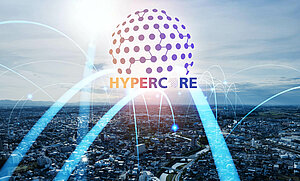October 22, 2024
The HYPERCORE project (“Energy-efficient, secure and high-performance communication infrastructure in the metro and core network for the hyper-connected society”), coordinated by Fraunhofer Heinrich-Hertz-Institut (HHI), was launched this summer. This joint project is dedicated to the development of a new generation of communication networks to achieve a significant increase in network capacity, flexibility and security — while keeping energy consumption low. As part of the project, Fraunhofer HHI is working on optimizing the metro and core networks that will serve as the backbone of tomorrow's hyper-connected society. HYPERCORE is being funded by the German Federal Ministry of Education and Research (BMBF) with more than six and a half million euros and will run for three years.
Digitalization is finding its way into more and more areas of life. Technologies such as the Internet of Things (IoT), autonomous vehicles and intelligent cities (smart cities) are no longer visionary fantasies of the future, but actively pursued goals of our society. Achieving these goals requires high-performance networks that can transmit enormous amounts of data in real time.
In recent years, transmission capacity in the metro and core network has mainly been driven forward by increasing the data rate per wavelength channel. However, this approach is increasingly reaching its physical limits. In a new approach, the HYPERCORE project examines a combination of all three physical dimensions available for increasing transmission capacity. This includes time (channel data rates), frequency (channel wavelengths) and space (number of spatial transmission channels). In this way, HYPERCORE will develop novel, more powerful and energy-efficient transmission and network concepts.
The HYPERCORE concept is based on four core technologies. The researchers will develop multiband transmission systems with an extended wavelength range and energy-efficient multiband transceivers. In addition, the project partners will design a coherent OTDR (Optical Time-Domain Reflectometry) system to automate network control using machine learning. Finally, the researchers will expand the digital twin technology for use in optical communication networks.
“An essential part of the HYPERCORE project is to evaluate the applicability of the developed technologies and thus lay the foundation for broad application throughout Europe.” explains Dr. Colja Schubert, head of the Submarine and Core Networks group at Fraunhofer HHI. “To this end, field tests will be carried out under real conditions in the regions Kiel and Berlin starting in spring 2026.”
Kiel University is providing a designated fiber optic network in collaboration with the network operator “Stadtwerke Kiel”. Here, the researchers will test the newly developed coherent OTDR systems. These systems will be able to retrieve additional information such as movements and vibrations in the area near the installed optical fibers, while also enabling data communication.
In a second setup in Berlin, researchers are evaluating novel transmitters and receivers in the O-band as well as energy-efficient signal processing algorithms in real applications with high data consumption (e.g. 8K video conferences).
The HYPERCORE project is focused on boosting network security and energy efficiency in order to help protect critical infrastructures and reduce the carbon footprint of digital applications.
In addition to the Fraunhofer HHI, other renowned research institutions and universities are involved: the University of the Federal Armed Forces in Munich, the Karlsruhe Institute of Technology, the Kiel University and the University of Stuttgart. The project is supported by leading industrial partners such as Adtran, VPIphotonics, CAD connect and ADDIX to enable rapid implementation of the developed technologies.
